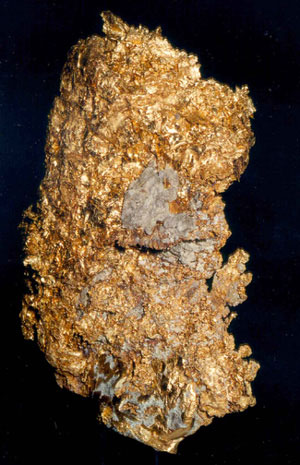After reading about everyday playful behaviour, such as humour and day-dreaming in the last blog by fellow ‘hand-picked’ blogger Dave Hemming, I was sitting here day-dreaming of a white Christmas and the three kings, and their myrrh, frankincense and gold. When I thought of gold I remembered screening Computers & Geosciences the other day, when I came across an interesting article, which I thought might be of interest for those of you who want to give something different this Christmas – how about finding your own gold deposit in time for Christmas? The article describes quantitative analysis of geo-scientific data to determine areas most likely to contain mineral deposits and is aimed at the mining industry. However, I can’t see why we all can’t have a go too. Read on to see how it’s done.

Gold nugget (Google images)
The article by Holden et al., 2008, which is entitled ‘Towards the automated analysis of regional aeromagnetic data to identify regions prospective for gold deposits’ is abstracted in CAB Abstracts. The paper presents an automatic image processing technique for the prospective analysis of gold deposits, based solely on aeromagnetic data and does not require any prior knowledge of locations of existing deposits. Instead, the aeromagnetic expressions of areas perceived to be geologically significant are sought within the aeromagnetic data.
The approach is based on characterising areas known to contain deposits and seeking similar areas elsewhere (you never know what lays beneath the rocks you walk on while hiking, you might be walking over undiscovered gold mines). Here is the clue – gold mineralisation is known to occur near major crustal breaks appearing as large-scale shear zones, which act as conduits for mineralising fluids (I’m sure the geologists among you have a good idea of what I’m talking about here).
Now that we know that mineralisation occurs in regions of structural complexity adjacent to the shear zones, we can progress towards the automatic detection of such regions. Step 1: firstly the system finds regions of magnetic discontinuity that correspond to both lithological boundaries and shear zones, using a combination of texture analysis and detection of symmetry features. Step 2: it examines the data gathered using fractal analysis. This will find areas nearby with a complex magnetic expression (zones of structural complexity). The most prospective areas are those where inferred structural complexity occurs adjacent to the regions of magnetic discontinuity. Once the area is found, get digging!
The authors report a preliminary experiment conducted using aeromagnetic data from an area in Western Australia and the regions selected using the above steps contained 76% of all known deposit locations and 82% of locations with deposits greater than one tonne.
Ok, it might be a bit optimistic to expect to find your gold before this Christmas, but come on this got to be easier than ‘bringing back the mammoth from the dead’! (see 'hand picked' blog by fellow blogger Cristina)
Reference
Holden, E.-J.; Dentith, M.; Kovesi, P. (2008). Towards the automated analysis of regional aeromagnetic data to identify regions prospective for gold deposits. Computers & Geosciences, 34:1505-1513.
2 Comments
Leave a Reply


Hmm..It is really great idea of some gold on Christmas. I have never think like that. This time I will surely go for it. I am planning of presenting some small gold jewelry pieces. What do you think ?
I couldn’t refrain from commenting. Very well written!